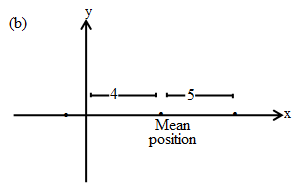11th And 12th > Physics
OSCILLATION AND SIMPLE HARMONIC MOTION MCQs
:
A
Let's analyze the motion
The path that the falling ball takes is same. The ball starts from A and hits the ground at B then rebounds on the same path AB to reach A and falls again continuing the motion (A - B - A - B - - - -)
Now in the motion from A to B,
u = 0
s = -h ; a = -g
s=ut+12 at2
−h=−12 gt2
Time taken to fall t =√2hg
Time taken to go back is same t =√2hg
Total time = 2√2hg , which is the "time period for this motion”
for (A - B - A)
since the collision was elastic the ball comes back to same point and falls again.
It follows the same path and takes the same time.
Is the motion repeating itself?
Well what do we mean by "motion repeats itself”
(1) Take a reference point (any point)
(2) Note time period of motion. Let it be 'T'
(3) Note particles position and velocity from the reference point at any time t, (t < T)
(4) Again note particles position and velocity from reference point at time (T + t)
(5) The result for (3) & (4) should be same for a motion to be periodic. Also, the time period of every cycle should be same
The above motion is periodic
Let's check whether it's oscillatory
Oscillatory definition:
Oscillatory Motion:- If the body moves to and fro under the influence of a restoring force then its called oscillatory motion There is no point for stable equilibrium. So no point of restoring force
:
C
y=A sinω t
A2=Asin2π12t;12=sinπ6t∴πt6=π6⇒t=1s
Swaison's Thrush (a fleet of small sized birds of an oscine family), while migrating fly far east across North America before turning south via Florida to reach northern South America. If they do this journey every year taking exactly the same time, to and fro on the same route with the same velocity profile then under which category can we put their motion.
:
B
You know that a motion that repeats itself in equal intervals of time is called periodic, right? Let's discuss what it means exactly. It means that after some specific interval of time T the position of the body from the reference point and its velocity are the same. So no matter what reference point you choose in the path, after time T the motion "repeats” itself. Well! Oscillatory motion is to and fro motion which may be periodic or not but the important thing about oscillatory motion is that it happens about a point of stable equilibrium where a restoring force exists. In the case mentioned in the problem there is no restoring force. However the motion repeats after equal intervals. So the motion is periodic but not Oscillatory!
:
B
Among these given graphs we need to figure out which has maximum K.E. at 4 seconds. Not a big deal! Let's just think through. Since the three experiments involve the same spring block system so the spring constant remains same for all. Now only (1) and (2) are in their mean position at t = 4 and (3) is in extreme so we can rule out (3). In the mean position K.E = T.E = 12KA2. Among (1) and (2), (1) has higher value of A(amplitude)
which we can see from the height it's bump!. So (1) has the maximum K.E.
Alternative way of thinking could be
Since this is a displacement - time graph and dxdtmeans velocity so the slope of this graph gives velocity.
More slope ⇒ more velocity ⇒ more K.E. Among (1) (2) and (3), (1) has the maximum slope (by observation) and so maximum K.E.
:
B
We are given x=A+B sinω t
We can see that the second term basically is the equation of an SHM with amplitude B. What's the first term doing there? Let's think about it. If it were just B sin ωt, it would be an SHM about the origin. Adding a constant to this entire thing would just shift the mean position from origin to x = A. Now the particle is doing SHM about x = A with an amplitude of B. Yes B! because amplitude is how far the particle goes from the mean position. The new means position is x = A but the particle's max displacement is still B from it!
A spring stretches by 0.05 m when a mass of 0.5 kg is hung from it. A body of mass 1.0 kg is attached to one of its ends, the other end being fixed to the wall. The body is pulled 0.01 m along a horizontal frictionless surface and released. What is the total energy of the oscillator. Assume the string to have negligible mass and take g=10ms−2
:
A
Force acting on spring = mg = 0.5 × 10 = 5N. This force extends the spring by 0.05 m. Therefore, the force constant is
k=50.05=100Nm−1
The angular frequency of horizontal oscillations is
ω=√km=√1001.0 rad s−1
The amplitude is A = 0.01 m. Therefore, total energy is
E=12mA2ω2=12×1.0×(0.01)2×(10)2=0.005J
Hence the correct choice is (a).
:
D
Kinetic energy (KE)=12mω2(A2−x2)
Potential energy (PE)=12mω2x2
Total energy (E)=12mω2A2When x=A2
KE = 12mω2(A2−A24)=38mω2A2E=12mω2A2∴KEE=34
:
C
E1=12mω2x2 or √E1=x√12mω2.......(1)
E2=12mω2y2 or √E2=y√12mω2.......(2)
E=12mω2(x+y)2 or √E=(x+y)√12mω2.......(3)
From (1), (2) and (3) it follows that
√E=√E1+√E2
Or E=E1+E2+2√E1E2
Which is choice (c).
:
D
Displacement x = +0.01 m. Therefore, acceleration a=−1.0ms−2.
Now a = −ω2x
Or -1.0 =−ω2×0.01
Which gives, ω=10 rad s−1 . Therefore, T=2πω=π5s.
Hence the correct choice is (d).





















